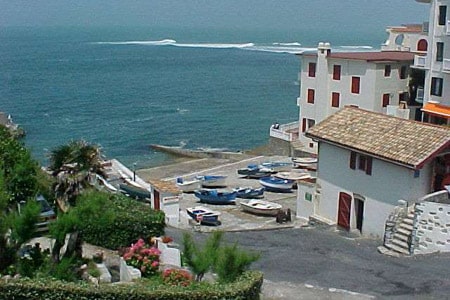Neighboring Bidart and Saint-Jean-de-Luz, Guéthary is the smallest village on the Basque coast, but it has more than one string to its bow to seduce and surprise its visitors. What to see, what to do, what to visit in Guéthary? Follow the guide!

Guéthary, a typical village on the Basque coast
Halfway between
Biarritz
and Saint-Jean-de-Luz, thirty kilometers from the Lou P’tit Poun campsite, Guéthary attracts surfers and tourists in search of authenticity. Its traditional Basque and neo-Basque architecture, with a touch of art deco, gives it a singular charm.
At the edge of the squares lined with bars and restaurants stand beautiful ox-blood-red half-timbered houses. In the center of the village, the fronton next to the town hall is the venue for grand chistera games. Olharroa (“the octopus” in Basque), founded in 1922 and nicknamed “the Mecca of grand chistera”, is one of the oldest clubs in the French Basque pelota federation. Dedicated to the patron saint of fishermen, Guéthary ‘s Saint-Nicolas church is also well worth a visit. It was erected in the 16th century on the highest point of the village to make it clearly visible from the sea. Look up and you’ll see an ex-voto ship hanging over the nave, bearing witness to Guéthary‘s maritime past.
The village is also known for its Art Deco heritage. The Itsasoan footbridge is one of the city’s most emblematic monuments. Inaugurated in 1927, at the same time as the Hôtel Casino, it was designed by French architect Henri Godbarge, theorist of the neo-Basque style. Another Art Deco gem to discover is the Guetharia, a former luxury hotel built on the seafront in the 1920s, which in its day played host to Charlie Chaplin, Vassily Kandinsky and Maurice Chevalier.
Guéthary also boasts a fine arts museum. Housed on the first floor of a sumptuous 19th-century neo-Basque villa, the museum boasts a rare collection of works by sculptor
Georges Clément de Swiecinski
. Exhibitions of contemporary art, paintings, sculptures and photography are scheduled from May to October.
Guéthary, beach side
Surfers are king here, with world-renowned spots such as Parlementia, Les Alcyons and Cenitz… In the heart of the Basque resort, the Port beach is a popular spot for families. Cenitz andHarotzen Costa beaches too. At low tide, the sea retreats to make way for a pool where children can swim safely. Please note that only Parlementia beach is supervised.
The port of Guéthary (without the whaling)
A whaling, tuna and sardine port, Guéthary is the smallest harbor on the Basque coast, which doesn’t detract from its charm – quite the contrary. You’ll notice the harbor’s steeply sloping surface, once used to hoist whales. In days gone by, fishermen used to hunt whales off Guéthary. When fishermen spotted whales from the watchtower, they would lower their drags from the harbor and set off to harpoon them. Today, the whales have long since deserted the bay and Guéthary has taken on the appearance of a marina. Twenty or so colorful boats fish quietly for sea bass, sea bream and chipiron.
DID YOU KNOW? Guéthary, in Basque Getaria, comes from the Latin “cetaria” meaning “salting place”. Indeed, around the 1st century, the Romans actually built a salting and garum (a condiment made from fermented fish) factory above the port.
La Terrasse: Guéthary’s VIP viewpoint
Overlooking the sea, the “Terrace” offers a breathtaking panorama of the Basque coast and the Parlementia surf spot, where the mythical wave can reach heights of up to five meters! It was built in 1912, in a place called “Place de la Croix”. Nearby, the Costa Aldia cross, which became the sailors’ cross in 1881, pays tribute to those lost at sea.
Ideas for walks and hikes
Guéthary is crossed by the coastal path, a great classic of hiking in the Basque Country, which links Bidart to Hendaye. Starting from the beach, the coastal path highlights the flora and fauna of Cenitz Bay, a site classified by the Conservatoire du Littoral. Between Guéthary and Saint-Jean-de-Luz, the Cenitz hill offers one of the finest views of the Bay of Biscay.
photo©CDT64
